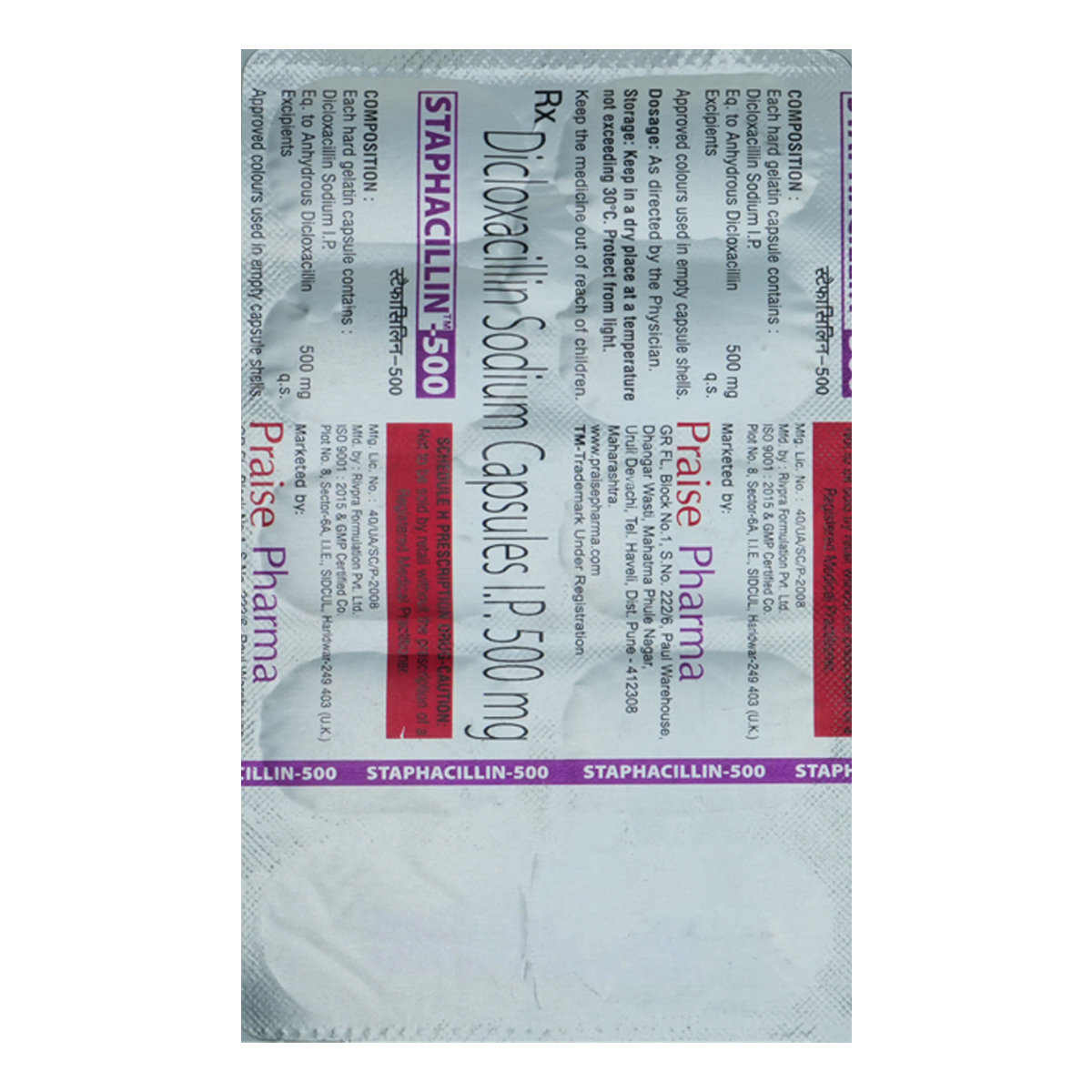Klox-D 500 Capsule


MRP ₹60.5
(Inclusive of all Taxes)
₹7.3 Cashback (12%)
know your delivery time
Provide Delivery Location
Composition :
Manufacturer/Marketer :
Consume Type :
Expires on or after :
Return Policy :

Secure Payment

Trusted by 8 Crore Indians

Genuine Products
Therapeutic Class
Country of origin
Manufacturer/Marketer address
Author Details
We provide you with authentic, trustworthy and relevant information
Disclaimer
Alcohol
Safe if prescribed
Avoid alcohol consumption while taking Klox-D 500 Capsule to prevent unpleasant side-effects, such as nausea and vomiting.
Pregnancy
Consult your doctor
It is not known if Klox-D 500 Capsule affects pregnancy. Please consult your doctor before taking Klox-D 500 Capsule if you are pregnant or planning to conceive.
Breast Feeding
Consult your doctor
Klox-D 500 Capsule is excreted into the breast milk and may harm a nursing baby. Please consult your doctor before taking Klox-D 500 Capsule if you are breastfeeding.
Driving
Safe if prescribed
It is unknown whether Klox-D 500 Capsule affects your ability to drive and operating machinery. Drive only if you are physically stable and mentally focussed. If you experience any dizziness after taking Klox-D 500 Capsule , do not drive or operate any machinery.
Liver
Consult your doctor
Let your doctor know if you have any history of liver diseases before taking Klox-D 500 Capsule . Your doctor will prescribe Klox-D 500 Capsule only if the benefits outweigh the risk.
Kidney
Consult your doctor
If you have any history of kidney diseases before taking Klox-D 500 Capsule , please inform your doctor. Your doctor will prescribe Klox-D 500 Capsule only if the benefits outweigh the risk.
Children
Safe if prescribed
Klox-D 500 Capsule is to be given to children only when prescribed by the doctor.
Product Substitutes
About Klox-D 500 Capsule
Klox-D 500 Capsule belongs to the 'antibiotics' class of drugs, primarily used to treat bacterial infections. It is used to treat various infections like bronchitis (inflammation of the lining of your bronchial tubes), pneumonia (infection in one or both lungs), or staphylococcal infections. Bacterial infection occurs when harmful bacteria grow in the body and causes illness. It can infect any part of the body and multiply very quickly.
Klox-D 500 Capsule contains Dicloxacillin, a penicillin antibiotic. It has bactericidal (ability to kill bacteria) activity against gram-positive and gram-negative aerobic (requires oxygen to survive) and anaerobic (survives with little or no oxygen) bacteria. Dicloxacillin binds to the penicillin-binding proteins (PBPs) inside the bacterial cell wall and inhibits cell wall synthesis.
Use Klox-D 500 Capsule as suggested by the doctor. Your doctor will advise the dose and duration based on the severity of your infection. Like all medicines, Klox-D 500 Capsule also causes side effects, although not everybody gets them. Common side effects of Klox-D 500 Capsule include heartburn, nausea, vomiting, diarrhea, red or swollen gums, and blisters/ulcers in the mouth. If any of these effects persist or worsen, seek medical advice promptly.
Brief your medical history to the doctor if you have any allergic reactions to antibiotics. Please inform your doctor if you have any liver, kidney diseases, bleeding disorders, and asthma. Do not use Klox-D 500 Capsule while having vaccinations with live bacterial vaccines (typhoid vaccine) since Klox-D 500 Capsule may affect the vaccine's activity. Klox-D 500 Capsule should be used during pregnancy only if the doctor advised you. It is also excreted into breast milk. Hence, it is recommended to consult your doctor if you are pregnant or breastfeeding before taking Klox-D 500 Capsule .
Uses of Klox-D 500 Capsule
Medicinal Benefits Mweb
Key Benefits
Klox-D 500 Capsule contains Dicloxacillin that belongs to the class of penicillin antibiotics. It has a bactericidal action against gram-positive and gram-negative aerobic and anaerobic bacteria. It acts by binding to the penicillin-binding proteins (PBPs) inside the bacterial cell wall and inhibits its cell wall synthesis. This process further leads to cell lysis or death. Thus, Klox-D 500 Capsule helps treat various bacterial infections. Klox-D 500 Capsule does not work for colds, flu, or other viral infections.
Directions for Use
Side Effects of Klox-D 500 Capsule
- Heartburn
- Nausea
- Vomiting
- Diarrhea
- Red or swollen gums
- Allergic reaction
- Blisters/ulcers in the mouth
Drug Warnings
If you have a history of any asthma, kidney disease, stomach problems (nausea, vomiting, digestive issues), bleeding disorders, and heart or liver diseases. Clostridium difficile associated diarrhea (CDAD) is reported during usage of antibiotics like Klox-D 500 Capsule . Therefore, please undergo an examination to rule out the chances of CDAD if you experience diarrhea following Klox-D 500 Capsule therapy. Let your doctor know if you are undergoing any vaccinations with live bacterial vaccines (like typhoid vaccine) since Klox-D 500 Capsule may affect vaccines' activity. Klox-D 500 Capsule should be used with caution during pregnancy. Klox-D 500 Capsule is also excreted into breast milk. Please seek medical advice if you are breastfeeding before taking Klox-D 500 Capsule . Sometimes, antibiotic medications can cause antibiotic resistance. In such cases, your doctor may prescribe other antibiotics, you are not resistant to.
Drug-Drug Interactions
Drug-Drug Interactions
Login/Sign Up
Co-administration of methotrexate with Klox-D 500 Capsule can increase the levels and effects of methotrexate. This can increase the risk or severity of serious infections.
How to manage the interaction:
Although there is a possible interaction between methotrexate and Klox-D 500 Capsule, you can take these medicines together if prescribed by your doctor. However, if you experience any symptoms such as nausea, vomiting, mouth ulcers, paleness, fatigue, dizziness, fainting, unusual bleeding or bruising, fever, chills, sore throat, body aches. Consult a doctor immediately. Do not stop using medications without a doctor's advice.
Drug-Food Interactions
Drug-Food Interactions
Login/Sign Up
Drug-Diseases Interactions
Drug-Diseases Interactions
Login/Sign Up
Drug-Drug Interactions Checker List
- WARFARIN
- METHOTREXATE
- TETRACYCLINE
Habit Forming
Special Advise
- Renal, hepatic, and blood function tests are advised during therapy.
- Penicillin antibiotics are easily removed during dialysis; hence let your doctor know if you are undergoing dialysis treatment so that the dose can be scheduled after the dialysis.
- Dicloxacillin may also affect liver function tests and urine glucose tests. Hence inform your doctor beforehand if you are using Klox-D 500 Capsule .
Diet & Lifestyle Advise
- Include more fiber-enriched food in your diet, as it can be easily digested by your gut bacteria, which helps stimulate their growth. Thus, fiber foods may help restore healthy gut bacteria after a course of antibiotics. Whole grains like whole-grain bread, brown rice should be included in your diet.
- Eating grapefruit during antibiotics treatment can prevent the body from utilizing Klox-D 500 Capsule properly. So, avoid intake of grapefruit or grapefruit juice with the antibiotic.
- Avoid intake of alcoholic beverages with Klox-D 500 Capsule as it can make you dehydrated and affect your sleep. This can make it more challenging for your body to aid the Klox-D 500 Capsule in fighting off infections.
- Manage stress, eat healthily, drink plenty of water, exercise regularly, and get plenty of sleep.
- Do not walk barefoot at places like gym showers to prevent bacterial infections.
All Substitutes & Brand Comparisons
RX
Out of StockLilyclox-500 Capsule 10's
Kham Pharma
₹99
(₹8.91 per unit)
67% COSTLIERRX
Out of StockStaphacillin-500 Capsule 10's
Praise Pharma
₹120
(₹10.8 per unit)
103% COSTLIER

Have a query?
Buy best Infections & Infestation products by
Cipla Ltd
Macleods Pharmaceuticals Ltd
Alkem Laboratories Ltd
Lupin Ltd
Abbott India Ltd
Sun Pharmaceutical Industries Ltd
Mankind Pharma Pvt Ltd
Micro Labs Ltd
Aristo Pharmaceuticals Pvt Ltd
FDC Ltd
Intas Pharmaceuticals Ltd
Glenmark Pharmaceuticals Ltd
Ipca Laboratories Ltd
Torrent Pharmaceuticals Ltd
Zydus Healthcare Ltd
Biochem Pharmaceutical Industries Ltd
Zuventus Healthcare Ltd
United Biotech Pvt Ltd
Hetero Drugs Ltd
Emcure Pharmaceuticals Ltd
Alembic Pharmaceuticals Ltd
Indoco Remedies Ltd
Fusion Health Care Pvt Ltd
Dr Reddy's Laboratories Ltd
Leeford Healthcare Ltd
Cadila Healthcare Ltd
Wockhardt Ltd
Zydus Cadila
GlaxoSmithKline Pharmaceuticals Ltd
Morepen Laboratories Ltd
Blue Cross Laboratories Pvt Ltd
Cadila Pharmaceuticals Ltd
Converge Biotech Pvt Ltd
Elder Pharmaceuticals Ltd
Hetero Healthcare Pvt Ltd
Pfizer Ltd
AAA Pharma Trade Pvt Ltd
Gufic Bioscience Ltd
Mylan Pharmaceuticals Pvt Ltd
Corona Remedies Pvt Ltd
Wallace Pharmaceuticals Pvt Ltd
Apex Laboratories Pvt Ltd
Medishri Healthcare Pvt Ltd
Akumentis Healthcare Ltd
Alniche Life Sciences Pvt Ltd
Hegde & Hegde Pharmaceutica Llp
Veritaz Healthcare Ltd
Ranbaxy Laboratories Ltd
Koye Pharmaceuticals Pvt Ltd
Shreya Life Sciences Pvt Ltd
Overseas Health Care Pvt Ltd
Biocon Ltd
Indchemie Health Specialities Pvt Ltd
Medley Pharmaceuticals Ltd
Brinton Pharmaceuticals Ltd
J B Chemicals & Pharmaceuticals Ltd
Unifaith Biotech Pvt Ltd
Ajanta Pharma Ltd
Biochemix Health Care Pvt Ltd
Natco Pharma Ltd
Samarth Life Sciences Pvt Ltd
Unichem International
Laborate Pharmaceuticals India Ltd
Unipark Biotech Pvt Ltd
Zymes Bioscience Pvt Ltd
Indiabulls Pharmaceuticals Pvt Ltd
Neon Laboratories Ltd
Vasu Organics Pvt Ltd
DR Johns Lab Pharma Pvt Ltd
East West Pharma India Pvt Ltd
La Renon Healthcare Pvt Ltd
Medgen Drugs And Laboratories Pvt Ltd
Novartis India Ltd
Canixa Life Sciences Pvt Ltd
Icarus Health Care Pvt Ltd
Lincoln Pharmaceuticals Ltd
Celon Laboratories Pvt Ltd
Concept Pharmaceuticals Ltd
Klm Laboratories Pvt Ltd
Nicholas Piramal India Ltd
Systopic Laboratories Pvt Ltd
Yuventis Pharmaceuticals
Capital Pharma
German Remedies Ltd
Pristine Pearl Pharma Pvt Ltd
Unison Pharmaceuticals Pvt Ltd
Aurz Pharmaceutical Pvt Ltd
Clover Health Care Pharma
Kepler Healthcare Pvt Ltd
Allites Life Sciences Pvt Ltd
Auspharma Pvt Ltd
Intra Life Pvt Ltd
Jolly Healthcare
Linux Laboratories Pvt Ltd
Ozone Pharmaceuticals Ltd
Cachet Pharmaceuticals Pvt Ltd
Comed Chemicals Ltd
Delcure Life Sciences Ltd
Fresenius Kabi India Pvt Ltd
Khandelwal Laboratories Pvt Ltd
Frequently Bought Together
₹101.1
MRP ₹121.5
17% off
1
+Customers Also Bought









